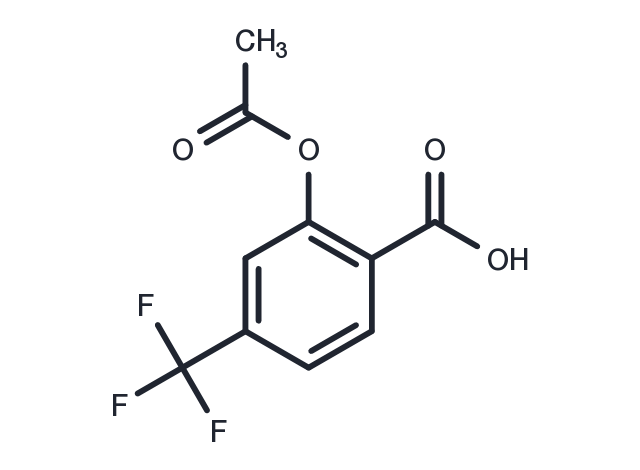Powder: -20°C for 3 years | In solvent: -80°C for 1 year


Triflusal (UR1501) is a 2-acetoxy-4-trifluoromethylbenzoic acid and it is an aspirin chemically-related molecule but not a derivative.

| Pack Size | Availability | Price/USD | Quantity |
|---|---|---|---|
| 5 mg | In stock | $ 39.00 | |
| 10 mg | In stock | $ 64.00 | |
| 25 mg | In stock | $ 118.00 | |
| 50 mg | In stock | $ 197.00 | |
| 100 mg | In stock | $ 328.00 | |
| 200 mg | In stock | $ 493.00 | |
| 500 mg | In stock | $ 789.00 | |
| 1 mL * 10 mM (in DMSO) | In stock | $ 43.00 |



| Description | Triflusal (UR1501) is a 2-acetoxy-4-trifluoromethylbenzoic acid and it is an aspirin chemically-related molecule but not a derivative. |
| Targets&IC50 | COX-2:160 μM (IC50, in human blood), COX-2:280 μM (IC50) |
| In vitro | The main Triflusal metabolite, HTB, preserves 6-keto-PGF1α synthesis in porcine aortic endothelial cells (PAEC) cells without a significant decline for up to 24 h even at the higher concentration. [1] Triflusal at 10 mM, 100 mM and 1 M decreases LDH efflux in rat brain slices after anoxia/reoxygenation by 24%, 35% and 49% respectively. Triflusal also reduces inducible NO synthase activity by 18%, 21% and 30%. [2] |
| In vivo | Triflusal (10 mg/kg i.v.) reduces platelet deposition on subendothelium-induced primary thrombus by about 68% in rabbits. Triflusal (10 mg/kg i.v.) reduces platelet deposition on a fresh thrombus formed over tunica media by about 48% in rabbits. Triflusal (40 mg/kg p.o.) reduces platelet deposition on a primary thrombus triggered by subendothelium and tunica media by 53% in rabbits. Triflusal (40 mg/kg p.o.) significantly reduces Cox-2 mRNA levels and protein levels without influence Cox-1 mRNA levels on the vascular wall in rabbits. [1] Triflusal (600 mg/day for 5 days) results in an increase in NO production by neutrophils and an increase in endothelial nitric oxide synthase (eNOS) protein expression in neutrophils in healthy volunteers. [3] Triflusal (300 mg, twice-daily orally) shows a more important increase in total walking distance and in pain-free walking distance over the basal values than those treated with placebo, together with an improvement of the symptomatology correlated with claudication in patients with chronic peripheral arteriopathy. Triflusal (300 mg, twice-daily orally) shows an increase in the peak-flow recorded through strain-gauge plethysmography in patients with chronic peripheral arteriopathy. [4] Triflusal (30 mg/kg) strongly decreases iNOS immunolabeling at both survival times analyzed, attenuating iNOS immunoreactivity in astroglial cells and infiltrated neutrophils in rats. Triflusal (30 mg/kg) decreases neuronal and microglial COX-2 expression at 10 and 24 hours after lesion and microglial and astroglial expression of IL-1beta and TNF-alpha at 24 hours after lesion in rats. [5] |
| Synonyms | UR1501 |
| Molecular Weight | 248.16 |
| Formula | C10H7F3O4 |
| CAS No. | 322-79-2 |
Powder: -20°C for 3 years | In solvent: -80°C for 1 year
Ethanol: 47 mg/mL (189.4 mM)
H2O: < 1 mg/mL (insoluble or slightly soluble)
DMSO: 47 mg/mL (189.4 mM)
You can also refer to dose conversion for different animals. More
bottom
Please see Inhibitor Handling Instructions for more frequently ask questions. Topics include: how to prepare stock solutions, how to store products, and cautions on cell-based assays & animal experiments, etc.
Triflusal 322-79-2 DNA Damage/DNA Repair Immunology/Inflammation Metabolism Neuroscience COX PPAR PDE inhibit Inhibitor Cyclooxygenase UR1501 UR 1501 UR-1501 inhibitor
